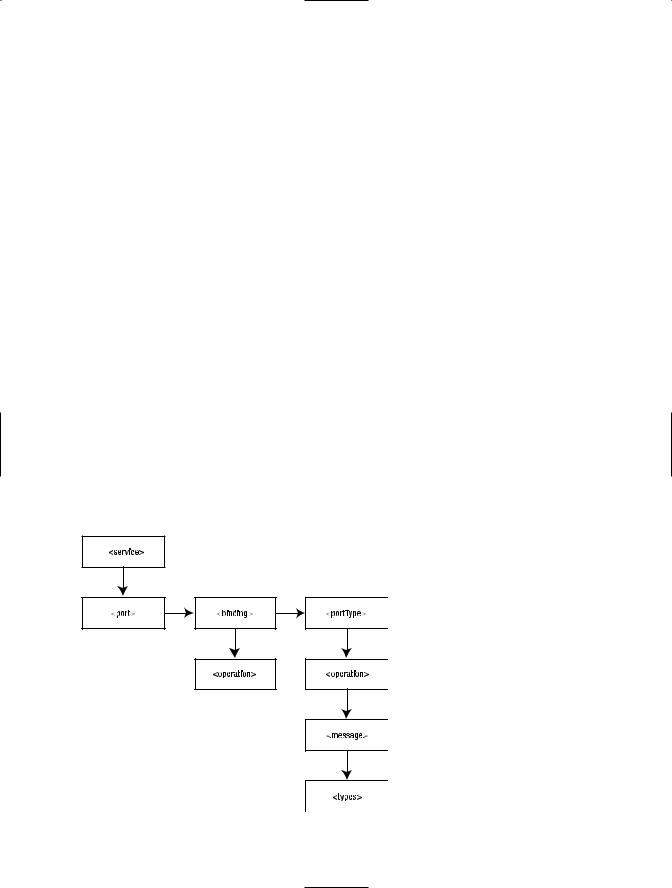
Expert Service-Oriented Architecture In CSharp 2005 (2006) [eng]
.pdf
16C H A P T E R 2 ■ T H E W E B S E R V I C E S D E S C R I P T I O N L A N G U A G E
elements take responsibility for describing different levels of detail. For example, the <message> element is a detailed listing of the types that factor into a given message. On the other hand, the <operation> element simply lists the messages that factor into a given operation without going into any detail as to what these messages look like. This additional
information would be unnecessary because the <message> element already does an excellent job of documenting the types that factor into a given message. This division of responsibility makes the WSDL document very efficient but at the same time hard to read, because you have to look in several places to assemble the full details of the documented Web service. But if you keep in mind that this is the approach that the WSDL document is following, you will find the document much easier to understand.
■Note All chapter code samples installed on a Windows 2003 server will try to install their web sites under IIS (Internet Information Services) if IIS is installed and configured. If IIS 6 is installed, make sure to configure .NET 2.0 to be the default version for IIS to use. Visual Studio will prompt you to convert the project to .NET 2.0 if this is not done.
The WSDL document is itself an XML document, so it obeys the rules that you expect for any well-formed XML document. This begins with schema namespace definitions, which are included as a root element in the WSDL document that’s using the <definitions> element. A typical WSDL document includes several schema definitions, but the most important one is the following:
<definitions xmlns="http://schemas.xmlsoap.org/wsdl/">
The <definitions> root element encloses the contents of the WSDL document entirely. All of the elements presented next are child elements of the <definitions> root element.
The WSDL document contains seven primary XML elements (in addition to the <definitions> root element), all of which belong to the schema listed previously. The seven XML elements fall into two main groups:
•Abstract description: XML elements that document the Web service interface, including the methods that it supports, the input parameters, and the return types
•Concrete implementation: XML elements that show the client how to physically bind to the Web service and to use its supported operations
There are four XML elements for abstract description:
<types>: This element lists all of the data types that are exchanged by the XML messages as input parameters or return types. The <types> element is equivalent to an embedded XSD schema definition file.
<message>: This element describes a SOAP message, which may be an input, an output, or a fault message for a Web service operation. A SOAP message is subdivided into parts that are represented by <part> child elements and that document the types that are included in the SOAP message.

C H A P T E R 2 ■ T H E W E B S E R V I C E S D E S C R I P T I O N L A N G U A G E |
17 |
<operation>: This element is analogous to a method definition; however, it only allows you to define input, output, and fault messages that are associated with the operation. You can then consult the individual message details to determine what input parameters and return types are involved.
<portType>: This element lists all of the operations that a Web service supports. The <port> element corresponds to a single Web service, while the <portType> element describes the available operations. The previous three elements (<types>, <message>, and <operation>) all describe granular, individual pieces of the Web service operations and its message types. The <portType> element avoids many of these lower-level details and instead provides a high-level summary of the operations (and associated input, output, and fault messages) that the Web service provides. The <portType> element provides a single location for a client to browse the offerings of a particular Web service.
There are three XML elements for concrete implementation:
<binding>: This element links the abstract and concrete elements together within a WSDL document. The <binding> element is associated with a specific <portType> element, and it also lists the address of the Web service that is associated with the <portType> element. Finally, the <binding> element lists the protocol that is used to communicate with the Web service.
<port>: This element defines the Uniform Resource Identifier (URI) where the Web service is located, and it also implements a <binding> element.
<service>: This element encloses one or more <port> elements.
Figure 2-1 shows the high-level structure of a WSDL document and how the various XML elements relate to each other within the document. The following sections examine each of the seven elements in further detail.
Figure 2-1. WSDL document structure

18 C H A P T E R 2 ■ T H E W E B S E R V I C E S D E S C R I P T I O N L A N G U A G E
The <types> Element
The <types> element lists all of the data types that are exchanged by the XML messages as input parameters or return types. The <types> element is equivalent to an embedded XSD schema definition file. For design purposes, it is useful to separate your XSD schema definitions into another file. This allows you to reference type information independently of the WSDL document, which is important because it provides a central reference point for validating XML documents against a single source. You can then import the XSD schema file into the WSDL document using a separate <import> root element as follows:
<import namespace="http://www.bluestonepartners.com/schemas/StockTrader/" location="http://www.bluestonepartners.com/schemas/StockTrader.xsd" />
With this approach the <types> element is no longer needed, so you can just include it as an empty element as follows:
<types/>
Having shown you this approach, we need to immediately point out that it does not conform to the WS-I Basic Profile, which states that the <import> element may only be used to import another WSDL document, not an external XSD schema file. You will still need to design and build XSD schema files separately from the WSDL document; however, once this task is complete, you will need to embed the XSD elements directly within the WSDL document’s <types> section. The <import> element must not appear within a WSDL document for XSD schema information. This rule holds true for WSDL documents that are generated by either WSE 2.0 or by WSE 3.0.
You cannot omit the <types> element, even if it is unused, because this will generate parsing errors in the WSDL document.
XSD schema definition files are described in detail in Chapter 3. They are essential documents for describing the data types of XML messages in an SOA. The discussion in Chapter 3 shows you how to build XSD schema files manually and then incorporate them into a WSDL document. You will also use XSD schema files to autogenerate code-based type definitions.
The <message> Element
The <message> element describes a SOAP message, which may be an input, an output, or a fault message for a Web service operation. A SOAP message is subdivided into parts that are represented by <part> child elements and that document the types that are included in the SOAP message.
For example, consider a Web method called RequestQuote. It accepts a stock ticker symbol and returns a complex XML Quote message, which contains multiple levels of detail, including the opening and closing prices of the stock, as well as long-term statistics such as 52-week high and low values. A client that expects to use the RequestQuote method does not care how this Web method is implemented. However, the client does need to know the structure of the messages for communicating with the Web method (or operation, as it is referred to in WSDL).

C H A P T E R 2 ■ T H E W E B S E R V I C E S D E S C R I P T I O N L A N G U A G E |
19 |
The RequestQuote operation uses a request (input) message and a response (output) message. The input message looks like this:
<message name="RequestQuoteSoapIn">
<part name="Symbol" element="s1:Symbol" /> </message>
The output message looks like this:
<message name="RequestQuoteSoapOut">
<part name="RequestQuoteResult" element="s1:Quote" /> </message>
Both messages use types from a namespace called StockTrader, which is referenced in the <definitions> element of the WSDL document. The <message> element does not need to document what these types look like; it simply needs to reference them. Notice that the operation’s parameters are documented within the <message> root element using <part> child elements. If the RequestQuote operation required five input parameters, the corresponding input <message> element would include five corresponding <part> child elements.
The <operation> Element
The <operation> element is analogous to a method definition; however, it only allows you to define input, output, and fault messages that are associated with the operation. You can then consult the individual message details to determine what input parameters and return types are involved.
In the previous section, we described the <message> element using an example operation called RequestQuote. We presented the input and output messages, but observant readers will notice that we did not formally associate these messages to the same operation beyond verbally stating that they were associated. This is what the <operation> element is for. It is responsible for formally associating messages with a given operation. The <message> element is a root element; so, in theory, you can define a message within the WSDL document and then use it across multiple operations. This is perfectly legal within the WSDL document.
Here is what the <operation> element looks like for the RequestQuote operation:
<operation name="RequestQuote">
<input message="tns:RequestQuoteSoapIn" /> <output message="tns:RequestQuoteSoapOut" /> <fault message="tns:ExceptionMessage" />
</operation>
Notice that no additional description is provided for the messages beyond their names. For more details, you must reference the corresponding <message> elements.
Operations can be defined in one of four modes:
•Request/Response: The client sends a request message to the Web service, and the Web service returns a response message.
•One Way: The client sends a request message to the Web service but receives no response message in return.

20C H A P T E R 2 ■ T H E W E B S E R V I C E S D E S C R I P T I O N L A N G U A G E
•Solicit/Response: This is the reverse of Request/Response. The Web service sends a message to the client, and then the client sends a response message to the Web service.
•Notification: This is the reverse of One Way. The Web service sends a message to the client but receives no response message in return.
The WSDL document does not contain special attributes for describing how an operation is called. Instead, you must infer this information by the arrangement and inclusion (or exclusion) of input and output messages. Although we have used the concept of request and response messages to describe the interaction between Web service and client, this model does not really apply in a WSDL document. Instead, we refer to input and output messages. The difference may be semantic, but in a WSDL document, Web services never make requests or send input messages to a client. Any message that originates from a Web service is referred to as an output message, even in Solicit/Response or Notification mode. Accordingly, here is how you define each of the four modes in WSDL:
•Request/Response: The client sends a request message to the Web service, and the Web service returns a response message.
<operation name="MyOperation"> <input message="MyInputMessage" />
<output message=" MyOutputMessage" /> </operation>
•One Way: The client sends a request message to the Web service but receives no response message in return.
<operation name="MyOperation"> <input message="MyInputMessage" />
</operation>
•Solicit/Response: This is the reverse of Request/Response. The Web service sends a message to the client, and then the client sends a response message to the Web service. The <operation> element lists the output and input messages in reverse order.
<operation name="MyOperation">
<output message=" MyOutputMessage" /> <input message="MyInputMessage" />
</operation>
•Notification: This is the reverse of One Way. The Web service sends a message to the client but receives no response message in return.
<operation name="MyOperation">
<output message=" MyOutputMessage" /> </operation>

C H A P T E R 2 ■ T H E W E B S E R V I C E S D E S C R I P T I O N L A N G U A G E |
21 |
The <portType> Element
The <portType> element lists all of the operations that a Web service supports. The <port> element (described later in this chapter) corresponds to a single Web service, while the <portType> element describes the available operations. The previous three elements (<types>, <message>, and <operation>) all describe granular, individual pieces of the Web service operations and its message types. The <portType> element avoids many of these lower-level details and instead provides a high-level summary of the operations (and associated input, output, and fault messages) that the Web service provides. The <portType> element provides a single location for a client to browse the offerings of a particular Web service.
The four elements that we have discussed so far are presented in order of decreasing granularity. Whereas an <operation> element lists a collection of <message> elements (which in turn list a collection of <types> elements), a <portType> element lists a collection of <operation> elements.
For example, here is the <portType> element (named StockTraderServiceSoap) for a Web service that supports two operations, RequestQuote and PlaceTrade:
<portType name="StockTraderServiceSoap"> <operation name="RequestQuote">
<input message="tns:RequestQuoteSoapIn" /> <output message="tns:RequestQuoteSoapOut" /> <fault message=" tns:ExceptionMessage" />
</operation>
<operation name="PlaceTrade">
<input message="tns:PlaceTradeSoapIn" /> <output message="tns:PlaceTradeSoapOut" />
</operation>
</portType>
You may be surprised to see the <portType> listing like this. We have pointed out on several occasions how the WSDL document is designed for efficiency. If this were entirely the case, then you would expect the <portType> element to look more like this:
<portType name="StockTraderServiceSoap">> <operation name="RequestQuote" /> <operation name="PlaceTrade" />
</portType>
There is no easy explanation as to why the WSDL document takes a less efficient approach with the <portType> element other than to speculate that it is designed to be a one-stop location for a client to retrieve a summary of the operations that the Web service supports.
The <binding> Element
The <binding> element links the abstract and concrete elements together within a WSDL document. The <binding> element is associated with a specific <portType> element, and it also lists the address of the Web service that is associated with the <portType> element. Finally, the <binding> element lists the protocol that is used to communicate with the Web service.

22 C H A P T E R 2 ■ T H E W E B S E R V I C E S D E S C R I P T I O N L A N G U A G E
Keep in mind that the <portType> element is nothing more than an abstract definition for a Web service, which is a concrete entity that implements a set of operations. The <binding> element simply formalizes the association between a <portType> and a Web service.
Here is what the <binding> element looks like for a Web service that supports a single operation called RequestQuote, and which communicates using the SOAP protocol:
<binding name="StockTraderServiceSoap" type="tns:StockTraderServiceSoap"> <soap:binding transport="http://schemas.xmlsoap.org/soap/http"
style="document" /> <operation name="RequestQuote"> <soap:operation
soapAction="http://www.bluestonepartners.com/schemas/StockTrader/RequestQuote" style="document" />
<input>
<soap:body use="literal" /> </input>
<output>
<soap:body use="literal" /> </output>
</operation>
</binding>
There is no new abstract information here that you do not already know from the discussion so far. For example, you already know the name of the <portType>, which is StockTraderServiceSoap. And you already know that it includes an <operation> element named RequestQuote. But the concrete information is new. The <binding> element informs you that the Web service uses the SOAP transport protocol. The <soap:operation> element tells you the name of the Web method that is associated with the RequestQuote operation, but it does not reveal the physical location of the Web service. (The soapAction attribute includes the namespace for the RequestQuote schema element, which appears to resemble a physical URL path.) Finally, you learned that the Web method uses literal encoding and a document style, which are both required settings for exchanging SOAP messages.
The <port> Element
The <port> element defines the URL where the Web service is located, and it also implements a <binding> element. As you know, we have already defined the <binding> element for the Web service, but it does not indicate the physical location of the Web service. This is what the <port> element is for.
Here is what the <port> element looks like for the StockTraderServiceSoap <binding> element:
<port name="StockTraderServiceSoap" binding="tns:StockTraderServiceSoap"> <soap:address location="http://localhost/StockTrader/StockTrader.asmx" />
</port>
Finally, you learn the physical location of the Web service, via the <soap:address> element.

C H A P T E R 2 ■ T H E W E B S E R V I C E S D E S C R I P T I O N L A N G U A G E |
23 |
The <service> Element
The <service> element encloses one or more <port> elements. It is essentially a collection of one or more Web service bindings. In most cases, your WSDL document will describe one Web service only, so the <service> element itself will provide no additional value. However, the WSDL specification requires that all <port> elements be contained within the <service> element. The listing in the previous section actually appears within a <service> element called StockTraderService as follows:
<service name="StockTraderService">
<port name="StockTraderServiceSoap" binding="tns:StockTraderServiceSoap"> <soap:address location="http://localhost/StockTrader/StockTrader.asmx" />
</port>
</service>
The WSDL 1.1 Specification
The WSDL 1.1 specification that describes the complete document structure can be found at http://www.w3.org/TR/wsdl. It is worth looking at the original specification because you will find useful elements that you can use even though they are not widely known or even generated using GUI tools such as Visual Studio .NET. For example, the <operation> element contains a child element called <documentation> that allows you to insert an English language description of what the operation does. Here is an example:
<operation name="RequestQuote"> <documentation>
Returns a delayed 30-minute quote for a given stock ticker symbol.
This operation returns a Quote XML type as defined in the XSD schema at: http://www.bluestonepartners.com/schemas/StockTrader.xsd
</documentation>
<input message="s1:RequestQuoteSoapIn" /> <output message="s1:RequestQuoteSoapOut" />
</operation>
The <documentation> element adds a welcome level of readability to the WSDL document, which is challenging at best to read with human eyes.
If you were to distill a WSDL document down to its most basic set of associated elements, it would look like this:
<definitions> <types /> <message /> <operation>
<message /> </operation> <portType>
<operation /> </portType>

24 C H A P T E R 2 ■ T H E W E B S E R V I C E S D E S C R I P T I O N L A N G U A G E
<binding> <operation />
</binding>
<service>
<port> <binding />
</port>
</service>
</definitions>
Listing 2-1 shows the actual WSDL document for the StockTrader Web service that we will be working with in detail in the following chapters. You do not need to read the document line-by-line; but try scanning it and notice how much information you can get about the Web service without having seen any other documentation about it.
Listing 2-1. The WSDL Document for the StockTrader Web Service
<?xml version="1.0" encoding="utf-8" ?>
<definitions xmlns:http="http://schemas.xmlsoap.org/wsdl/http/" xmlns:soap="http://schemas.xmlsoap.org/wsdl/soap/" xmlns:s="http://www.w3.org/2001/XMLSchema" xmlns:s0="http://www.bluestonepartners.com/schemas/StockTrader/" xmlns:soapenc="http://schemas.xmlsoap.org/soap/encoding/" xmlns:tns="http://www.bluestonepartners.com/schemas/StockTrader" xmlns:tm="http://microsoft.com/wsdl/mime/textMatching/" xmlns:mime="http://schemas.xmlsoap.org/wsdl/mime/" targetNamespace="http://www.bluestonepartners.com/schemas/StockTrader" xmlns="http://schemas.xmlsoap.org/wsdl/">
<import namespace="http://www.bluestonepartners.com/schemas/StockTrader/" location="http://www.bluestonepartners.com/schemas/StockTrader.xsd" />
<types/>
<message name="RequestAllTradesSummarySoapIn"> <part name="Account" element="s1:Account" />
</message>
<message name="RequestAllTradesSummarySoapOut">
<part name="RequestAllTradesSummaryResult" element="s1:Trades" /> </message>
<message name="RequestTradeDetailsSoapIn"> <part name="Account" element="s1:Account" /> <part name="TradeID" element="s1:TradeID" />
</message>
<message name="RequestTradeDetailsSoapOut">
<part name="RequestTradeDetailsResult" element="s1:Trade" /> </message>
<message name="PlaceTradeSoapIn">
<part name="Account" element="s1:Account" /> <part name="Symbol" element="s1:Symbol" /> <part name="Shares" element="s1:Shares" />

C H A P T E R 2 ■ T H E W E B S E R V I C E S D E S C R I P T I O N L A N G U A G E |
25 |
<part name="Price" element="s1:Price" />
<part name="tradeType" element="s1:tradeType" /> </message>
<message name="PlaceTradeSoapOut">
<part name="PlaceTradeResult" element="s1:Trade" /> </message>
<message name="RequestQuoteSoapIn">
<part name="Symbol" element="s1:Symbol" /> </message>
<message name="RequestQuoteSoapOut">
<part name="RequestQuoteResult" element="s1:Quote" /> </message>
<portType name="StockTraderServiceSoap"> <operation name="RequestAllTradesSummary">
<input message="tns:RequestAllTradesSummarySoapIn" /> <output message="tns:RequestAllTradesSummarySoapOut" />
</operation>
<operation name="RequestTradeDetails">
<input message="tns:RequestTradeDetailsSoapIn" /> <output message="tns:RequestTradeDetailsSoapOut" />
</operation>
<operation name="PlaceTrade">
<input message="tns:PlaceTradeSoapIn" /> <output message="tns:PlaceTradeSoapOut" />
</operation>
<operation name="RequestQuote">
<input message="tns:RequestQuoteSoapIn" /> <output message="tns:RequestQuoteSoapOut" />
</operation>
</portType>
<binding name="StockTraderServiceSoap" type="tns:StockTraderServiceSoap"> <soap:binding transport="http://schemas.xmlsoap.org/soap/http"
style="document" />
<operation name="RequestAllTradesSummary"> <soap:operation
soapAction="http://www.bluestonepartners.com/schemas/StockTrader/ RequestAllTradesSummary" style="document" />
<input>
<soap:body use="literal" /> </input>
<output>
<soap:body use="literal" /> </output>
</operation>
<operation name="RequestTradeDetails"> <soap:operation
soapAction="http://www.bluestonepartners.com/schemas/StockTrader/
